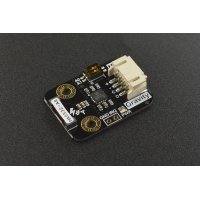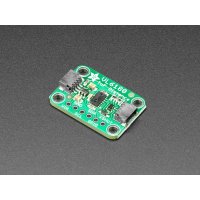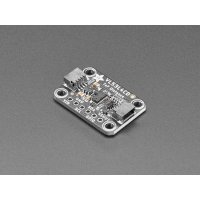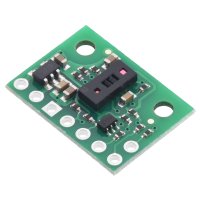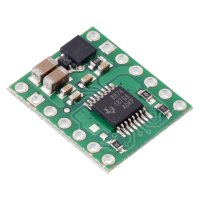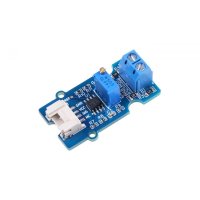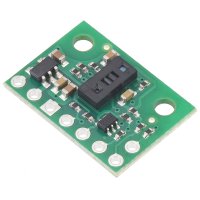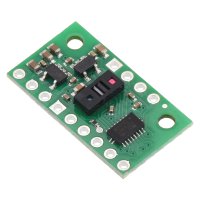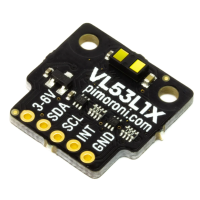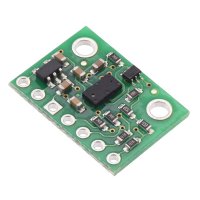- VL53L0X - 200cm
- VL53L1X - 400cm
- VL6180X - 60cm
| SL | VL6180X |
|
VL53L1X | VL53L3CX | |
| Dimensions | 0.5″ × 0.7″ × 0.085″ (13 mm × 18 mm × 2 mm) | 0.5″ × 0.7″ × 0.085″ (13 mm × 18 mm × 2 mm) | 0.5″ × 0.7″ × 0.085″ (13 mm × 18 mm × 2 mm) | 0.5″ × 0.7″ × 0.085″ (13 mm × 18 mm × 2 mm) | |
| Weight without header pins | 0.5 g (0.02 oz) | 0.5 g (0.02 oz) | 0.5 g (0.02 oz) | 0.5 g (0.02 oz) | |
| Operating Voltage | 2.7 V to 5.5 V | 2.6 V to 5.5 V | 2.6 V to 5.5 V | 2.6 V to 5.5 V | |
| Supply Current | 5 mA (typical; varies with configuration, target, and environment) | 10 mA (typical average during active ranging) | ~15 mA | ~15 mA | |
| Output format (I2C) | 8-bit distance reading (in millimeters), 16-bit ambient light reading |
10 mA (typical average during active ranging)
Varies with configuration, target, and environment. Peak current can reach 40 mA.
|
16-bit distance reading (in millimeters) | histogram | |
| Distance measuring range | up to 10 cm (4″) specified; up to 60 cm (24″) possible with reduced resolution. See the graph at the right for typical ranging performance. |
up to 2 m (6.6 ft);
Effective range depends on configuration, target, and environment.
|
Short: up to ~130 cm, 50 Hz max sampling rate;
Medium: up to ~300 cm in the dark, 30 Hz max
Long: up to 400 cm in the dark, 30 Hz max
Minimum range: 4 cm
|
Maximum range: 3 m (10 ft)
Resolution: 1 mm
Minimum range: 10 mm (0.4 in)
Emitter: 940 nm invisible Class 1 VCSEL
Detector: SPAD
FoV: 25°
|
Package Includes:
- 1 x Pololu 2489/2490/3415/3416 Time-of-Flight Distance Sensor Carrier with Voltage Regulator VL53L0X/ VL53L1X/ VL6180X
| Electrical Specifications | |
| Input Current | Supply Current - 2489-5mA, 2490-10mA, 3415/3416-15mA |
| Minimum Operating Voltage | 2489-2.7V, 2490/3415/3416-2.6V |
| Maximum Operating Voltage | 5.5V |
| Physical Attributes | |
| Weight | 0.5 g |
| Dimensions | 0.5″ × 0.7″ × 0.085″ |
Pololu 2489/2490/3415/3416 Time-of-Flight Distance Sensor Carrier with Voltage Regulator VL53L0X/ VL53L1X/ VL6180X
- Brand: Pololu
- Product Code: Pololu-Time-of-Flight-Distance-Sensor-Carrier-Voltage
- Reward Points: 10
- Availability: In Stock
- रo 1,064.00
-
रo 1,022.00
- Price in reward points: 1064
-
- 13 or more रo 1,056.00
- 25 or more रo 1,018.00
- 96 or more रo 965.00
- 124 or more रo 1,110.00
Available Options
Related Products
Adafruit 3317 VL53L0X Time of Flight Distance Sensor - ~30 to 1000mm
The VL53L0X is a Time of Flight distance sensor like no other you've used! The sensor contains a ver..
रo 1,816.00
IR Distance Sensor - Sharp GP2Y0A21YK0F
IR Distance Sensor - Sharp GP2Y0A21YK0F with wire connector Features and Specifications: ..
रo 481.00
Laser Ranging Sensor World Smallest Time-of-Flight (ToF) GY-530 VL53L0X
Infrared distance measurement module Model: GY - VL53L0X Using the chi..
रo 387.00
Pololu 2579 38kHz IR Proximity Sensor, Fixed Gain, Low Brightness
These sensor modules are based on Vishay’s TSSP77038 modulated infrared receivers. Unlike most IR re..
रo 527.00 रo 549.00
Pololu 2464 Analog Distance Sensor - 4-30cm Sharp GP2Y0A41SK0F
The GP2Y0A41SK0F Sharp analog distance sensor features a detection range of 1.5″ to 12″ (4 cm to 30 ..
रo 1,093.00 रo 1,301.00
Pololu 1131/1135/2466 Digital Distance Sensor - Sharp GP2Y0D805Z0F, GP2Y0D810Z0F, GP2Y0D815Z0F
This small digital distance sensor detects objects between 2 cm and 10 cm (0.8″ and 4″) away. With i..
रo 697.00
Pololu 2474 Carrier with Sharp GP2Y0A60SZLF Analog Distance Sensor 10-150cm
The GP2Y0A60SZ distance sensor from Sharp offers a wide detection range of 4″ to 60″ (10 cm ..
रo 1,668.00 रo 1,763.00
Gravity: Lightning Distance Sensor
Gravity: Lightning Sensor employs AMS innovative AS3935 Franklin lightning sensor IC and Coilcraft M..
रo 1,781.00 रo 2,120.00
Adafruit 3316 VL6180X Time of Flight Distance Ranging Sensor (VL6180) - STEMMA QT
The VL6180X (sometimes called the VL6180) is a Time of Flight distance sensor like no other you've u..
रo 1,506.00
Adafruit 5396 VL53L4CD Time of Flight Distance Sensor - ~1 to 1300mm - STEMMA QT / Qwiic
The Adafruit VL53L4CD Time of Flight Sensor is another great Time of Flight distance sensor from ST ..
रo 1,614.00
Pololu 3417 VL53L5CX Time-of-Flight 8×8-Zone Distance Sensor Carrier with Voltage Regulator, 400cm Max
FschemThis sensor is a carrier/breakout board for ST’s VL53L5CX laser-ranging sensor, which offers f..
रo 1,512.00 रo 1,575.00
Pololu 4035/4036/4037 Single Brushed DC Motor Driver Carrier DRV8874/DRV8876/DRV8876 (QFN)
This compact breakout board for TI’s DRV8874/DRV8876/ DRV8876 (QFN)motor driver offers a wide o..
रo 542.00 रo 565.00
Grove AC-Voltage sensor
Grove AC Voltage Sensor is perfect for measuring RMS AC voltages for accurate DIY energy meters. It ..
रo 408.00
Pololu 3418 VL53L7CX Time-of-Flight 8×8-Zone Wide FOV Distance Sensor Carrier with Voltage Regulator, 350cm Max
This sensor is a carrier/breakout board for ST’s VL53L7CX laser-ranging sensor, which offers fast an..
रo 1,512.00 रo 1,575.00
Pololu 3419 VL53L8CX Time-of-Flight 8×8-Zone Distance Sensor Carrier with Voltage Regulators, 400cm Max
This sensor is a carrier/breakout board for ST’s VL53L8CX laser-ranging sensor, which offers fast an..
रo 1,892.00 रo 1,971.00
Pimoroni VL53L1X Time of Flight (ToF) Sensor Breakout
An all-singing, all-dancing time of flight distance sensor that uses PEW PEW LASERS (low-powered one..
रo 2,598.00
Pololu 3692 VL53L4CD Time-of-Flight Distance Sensor Carrier with Voltage Regulator, 120cm Max
This sensor is a carrier/breakout board for ST’s VL53L4CD laser-ranging sensor, which offers fast (u..
रo 1,157.00
Tags: VL53L0X, VL53L1X, VL6180X, Time-of-Flight, Distance, Sensor, Carrier, Voltage, Regulator, 60cm, 200cm, 400cm

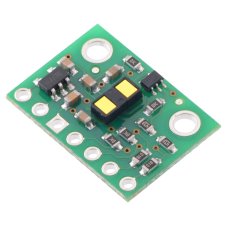
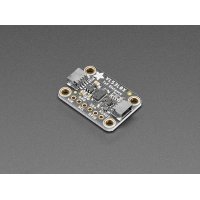
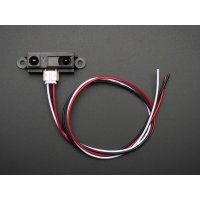
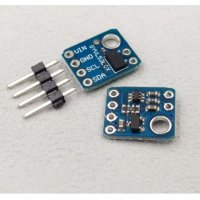
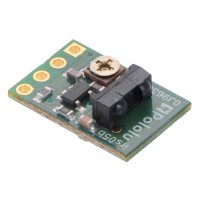
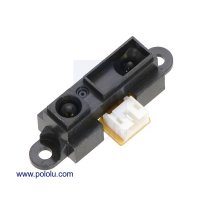
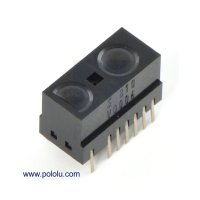
-200x200.jpg)
